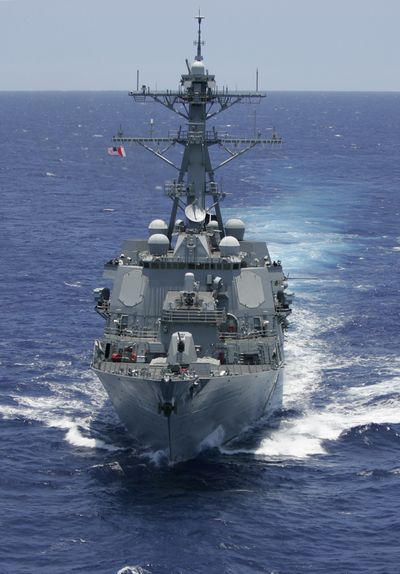U.S., Russian ships pursue pirates
Hijacked ship was transporting tanks to Kenya

NAIROBI, Kenya – A U.S. destroyer and a Russian warship headed Saturday for a possible confrontation with pirates who hijacked a cargo ship off the Somali coast loaded with battle tanks, machine guns and a crew of 21.
A U.S. defense official said the destroyer USS Howard was pursuing the hijacked Ukrainian vessel and was within a few thousand yards of it. The hijacked ship was anchored a few miles off the Somalia coast, said the official who spoke on condition of anonymity due to the sensitive nature of the situation.
The USS Howard’s Web site says it is equipped for combat operations at sea with surface-to-air missiles, Tomahawk cruise missiles, antisubmarine rockets, torpedoes and a five-inch rapid-fire deck gun.
Despite being pursued by ships from two of the world’s biggest naval powers, the pirates showed no sign of surrendering the Ukrainian vessel Fainia, which they boarded Thursday as it was transporting 33 Russian-built T-72 tanks to Kenya. Instead, unconfirmed reports said they were demanding a $35 million ransom to turn over their unconventional booty.
The pirates also warned against any raids by the U.S. or Russian navy.
The brazen seizure occurred in notoriously dangerous international waters off the Horn of Africa, where pirates are able to exploit Somalia’s lawlessness. A Greek oil tanker was seized nearby by pirates on Friday, maritime officials said. And twice this year, French commandos have intervened to rescue its citizens taken hostage off Somalia.
Pirates operate with relative freedom and impunity in and around the Somalian port city of Eyl in the semi-autonomous Puntland region, where officials say more than 300 hostages are being held and several hijacked ships are docked.
“These pirates are well-armed groups with rocket-propelled grenades and automatic weapons,” said Bile Mohamoud Qabowsade, a senior Puntland government adviser. “Even super-power governments have been unable to chase away the pirates. What do you think a feeble, semi-autonomous Puntland government can do?”
While the fate of the Fainia remains unresolved, the bizarre nature of the cargo has put greater scrutiny on the rampant piracy off Somalia’s coast. The international community only recently has begun to respond to the threat to commercial and recreational vessels plying these waters. Even naval ships bristling with sophisticated weaponry might not be immune from attack. Earlier this month, the U.S. Navy said one of its ships appeared to have been fired upon by pirates.
Since the 1991 collapse of its government, Somalia has suffered through civil war, clan divisions, famine and, most recently, an Islamist insurgency. For the most part, its troubles have been confined to the country’s borders since the U.N. abandoned its mission following a helicopter attack that killed 18 American servicemen in 1993.
The attacks in the Gulf of Aden and Indian Ocean are pushing Somalia’s lingering problems onto the international stage.
“This piracy is starting to draw international attention,” said Abdisaid Muse Ali, a security expert and former Somalia government official. “The latest attack was a real shock.”
Some people questioned why the Ukrainian vessel, loaded with weapons and delivering goods as part of a government-to-government transaction, traveled through some of the world’s most dangerous waters without any security. Kenyan officials on Saturday dismissed reports about a $35 million ransom demand; the arms taken by the pirates were intended to go to the Kenyan military.
But experts predict a ransom payment is still the most likely outcome because a raid might endanger hostages.